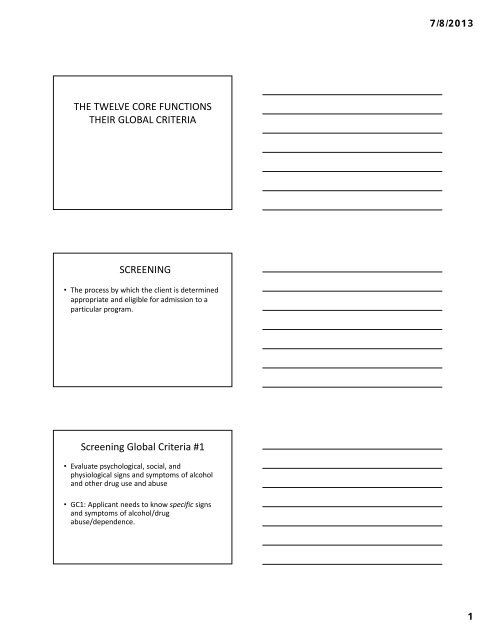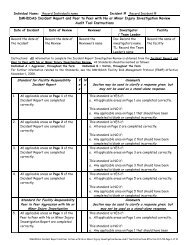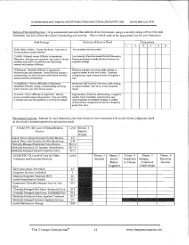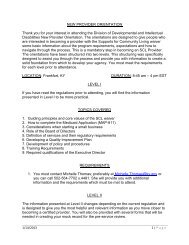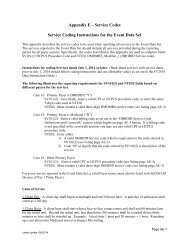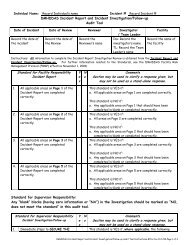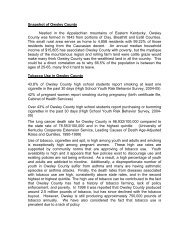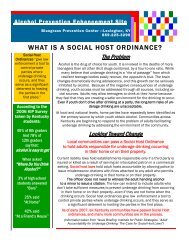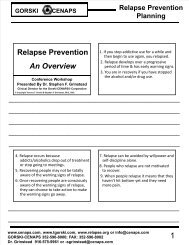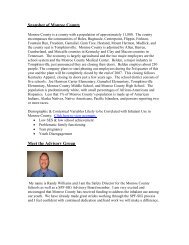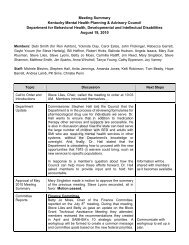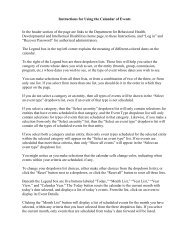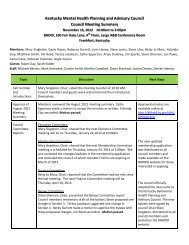THE TWELVE CORE FUNCTIONS THEIR GLOBAL CRITERIA ...
THE TWELVE CORE FUNCTIONS THEIR GLOBAL CRITERIA ...
THE TWELVE CORE FUNCTIONS THEIR GLOBAL CRITERIA ...
You also want an ePaper? Increase the reach of your titles
YUMPU automatically turns print PDFs into web optimized ePapers that Google loves.
7/8/2013<br />
<strong>THE</strong> <strong>TWELVE</strong> <strong>CORE</strong> <strong>FUNCTIONS</strong><br />
<strong>THE</strong>IR <strong>GLOBAL</strong> <strong>CRITERIA</strong><br />
SCREENING<br />
• The process by which the client is determined<br />
appropriate and eligible for admission to a<br />
particular program.<br />
Screening Global Criteria #1<br />
• Evaluate psychological, social, and<br />
physiological signs and symptoms of alcohol<br />
and other drug use and abuse<br />
• GC1: Applicant needs to know specific signs<br />
and symptoms of alcohol/drug<br />
abuse/dependence.<br />
1
7/8/2013<br />
Client had been drinking daily for six<br />
months<br />
• This client is alcoholic<br />
• This client is eligible for antabuse.<br />
• This client needs treatment<br />
• This client has no problems.<br />
• Not enough information given.<br />
Screening Global Criteria #2<br />
• Determine the client’s appropriateness for admission or<br />
referral.<br />
• GC2: Applicant must know what makes a client APPROPRIATE<br />
for treatment offered. Look for substantiation of substance<br />
abuse problem, matching of client to program modality or<br />
level of care, dual diagnosis, medical status, intellectual and<br />
psychological functioning.<br />
Screening Global Criteria #3<br />
• Determine the client’s eligibility for admission or<br />
referral.<br />
• GC: Applicant must understand what makes a client<br />
eligible for treatment. This includes age, gender,<br />
place of residence, ability to pay, target populations,<br />
veteran status, etc.<br />
2
7/8/2013<br />
Which may be the correct answer?<br />
• The client was eligible for treatment because<br />
he was alcoholic.<br />
• The client was eligible for treatment because<br />
he was alcoholic, a male over 18 and had no<br />
co‐occurring illnesses.<br />
Screening Global Criteria #4<br />
• Identify any coexisting conditions (medical,<br />
psychiatric, physical, etc.) that indicate need for<br />
additional professional assessment and/or service.<br />
• GC 4: Applicant must understand coexisting<br />
conditions (psychiatric dx, medical conditions,<br />
cognitive impairment, etc.) that indicate a need for<br />
further assessment or referral elsewhere.<br />
Screening Global Criterion #5<br />
• Adhere to applicable laws, regulations and agency<br />
policies governing alcohol and other drug abuse<br />
services.<br />
• GC5: Applicant must understand how federal and<br />
state laws and agency policies impact screening<br />
process ie. Methadone, HIPPA, etc.<br />
3
7/8/2013<br />
The client signed insurance papers and completed a<br />
demographic sheet. A copy was made of his insurance<br />
card and driver’s license.<br />
• This is a good example of gathering<br />
information during the screening process.<br />
• Yes<br />
• NO<br />
INTAKE<br />
• The administrative and initial assessment<br />
procedures for admission to a program<br />
Intake Global Criteria #6<br />
• Complete required documents for admission to the<br />
program.<br />
• GC6: Applicant understands that during the intake<br />
process documents are completed and information is<br />
written down. This refers to the administrative<br />
documentation necessary for admission (consent for<br />
treatment, demographic information,<br />
4
7/8/2013<br />
Intake Global Criteria #7<br />
• Complete required documents for program<br />
eligibility and appropriateness.<br />
• GC7: Must know information such as<br />
financial, income, employment demographics,<br />
AODA screening, etc. was written down.<br />
Intake Global Criteria # 8<br />
• Obtain appropriately signed consents.<br />
• GC8: Must understand about releases of<br />
information.<br />
During the phone call, information was gathered about the<br />
client’s drug use, his medical condition, history of withdrawal,<br />
prior treatment attempts, current living and legal situation and<br />
current support system.<br />
• This is an example of:<br />
• Screening<br />
• Intake<br />
5
7/8/2013<br />
ORIENTATION<br />
Describing to the client the following: general nature<br />
and goals of the program; rules governing client<br />
conduct and infractions that can lead to disciplinary<br />
action or discharge from the program; in a nonresidential<br />
program, the hours during which services<br />
are available; treatment costs to be borne by the<br />
client, if any; any client rights.<br />
ORIENTATION <strong>GLOBAL</strong> <strong>CRITERIA</strong> # 9<br />
• Provide an overview to the client by describing<br />
program goals and objectives for client care.<br />
• GC9: Must know specific examples of program goals<br />
and objectives; ie. supporting abstinence, learning<br />
sober coping skills, providing a safe environment for<br />
developing social relationships, etc.<br />
ORIENTATION <strong>GLOBAL</strong> <strong>CRITERIA</strong> #<br />
10<br />
• Provide an overview to the client by describing<br />
program rules, and client obligations and rights.<br />
• GC10: Must know specific program rules<br />
(attendance, no drugs or weapons) specific client<br />
obligations (fees, punctuality, participation) client<br />
rights (respect, confidentiality, grievance). 2 out or 3<br />
6
7/8/2013<br />
ORIENTATION <strong>GLOBAL</strong> <strong>CRITERIA</strong> #<br />
11<br />
• Provide an overview to the client of program<br />
operations.<br />
• GC11: Must know specific examples of how the<br />
program operates and is structured and what the<br />
client needs to know to access and utilize program<br />
services. This may include hours of operation, after<br />
hours emergency contact numbers, availability of<br />
staff, activities, etc.<br />
Orientation includes:<br />
Choose all that apply:<br />
• Program hours, staff availability<br />
• Emergency Procedures<br />
• Client Obligations<br />
• Client Rights<br />
• Program goals and objectives<br />
ASSESSMENT<br />
• The procedures by which a counselor/program<br />
identifies and evaluates an individual’s<br />
strengths, weaknesses, problems and needs<br />
for the development of a treatment plan.<br />
7
7/8/2013<br />
ASSESSMENT <strong>GLOBAL</strong> <strong>CRITERIA</strong> #<br />
12<br />
• Gather relevant history from client including<br />
but not limited to AODA using appropriate<br />
interview techniques.<br />
• GC12: Must know areas of client history<br />
(social, AODA, legal, family, medical, etc.)<br />
relevant to assessment.<br />
ASSESSMENT <strong>GLOBAL</strong> <strong>CRITERIA</strong> #<br />
13<br />
Identify methods and procedures for obtaining<br />
corroborative information from significant secondary<br />
sources.<br />
GC13: Must understand what corroborative<br />
information is, who to obtain from, and why it is<br />
important to the assessment process.<br />
ASSESSMENT <strong>GLOBAL</strong> <strong>CRITERIA</strong> #<br />
14<br />
Identify appropriate assessment tools.<br />
GC14: Must know and understand assessment<br />
tools (psychosocial, ASI, SASSI, etc.)<br />
8
7/8/2013<br />
ASSESSMENT <strong>GLOBAL</strong> <strong>CRITERIA</strong><br />
#15<br />
• Explain to the client the rationale for the use of<br />
assessment techniques in order to facilitate<br />
understanding.<br />
• GC15: Must know why it’s necessary to help the<br />
client understand the assessment process.<br />
ASSESSMENT <strong>GLOBAL</strong> <strong>CRITERIA</strong> #<br />
16<br />
• Develop a diagnostic evaluation of the client’s<br />
substance abuse and any coexisting<br />
conditions based on the results…<br />
• GC16: Must be able to formulate a diagnosis<br />
from the assessment results.<br />
Client had been drinking alcohol daily for ten years in increasing quantities<br />
and using crack cocaine for three years. He has had numerous arrests and job<br />
losses and is separated from his wife and two children. He appears thin,<br />
slightly tremulous and agitated.<br />
Based on above assessment this client probably suffers from:<br />
• A ‐ Alcohol Abuse<br />
• B ‐ Cocaine Abuse<br />
• C ‐ Alcohol dependence<br />
• D ‐ Cocaine Dependence<br />
• E –A and B<br />
• F –C and D<br />
9
7/8/2013<br />
TREATMENT PLANNING<br />
• Process by which the counselor and the client<br />
identify and rank problems needing<br />
resolution; establish agreed upon immediate<br />
and long‐term goals; an decide upon a<br />
treatment process and the resources to be<br />
utilized.<br />
Treatment Planning Global Criteria<br />
# 17<br />
• Explain assessment results to client in an<br />
understandable manner.<br />
• GC17: Must know that results of the<br />
assessment need to be explained to the client<br />
in an understandable manner.<br />
Treatment Planning Global Criteria<br />
# 18<br />
• Identify and rank problems based on<br />
individual client needs in the written<br />
treatment plan.<br />
• GC18: Must be able to prioritize problems and<br />
individualize the<br />
treatment plan.<br />
10
7/8/2013<br />
Treatment Planning Global Criteria<br />
# 19<br />
• Formulate agreed upon immediate and long‐term<br />
goals using behavioral terms in the written treatment<br />
plan.<br />
• GC19: Identify examples of client goals (short and<br />
long‐term) written in behavioral terms. Always<br />
include client participation in goal setting.<br />
Identify short term goals<br />
• Safe detox<br />
• Reunite with children<br />
• Get an AA sponsor<br />
• Participate in program<br />
• Seek housing<br />
• Meet with case manager<br />
• Become a CADC<br />
Treatment Planning Global Criteria<br />
# 20<br />
• Identify the treatment methods and resources<br />
utilized as being appropriate for the individual<br />
client.<br />
• GC20: Know techniques and resources which<br />
can be used to address problems.<br />
11
7/8/2013<br />
COUNSELING<br />
• (Individual, Group, and Significant Others): The<br />
utilization of special skills to assist individuals,<br />
families or groups in achieving objectives through<br />
exploration of a problem and its ramifications;<br />
examination of attitudes and feelings; consideration<br />
of alternative solutions; and decision‐making.<br />
Counseling Global Criteria # 21<br />
• Select the counseling theory (ies) that apply<br />
(ies)<br />
• GC21: Applicant must have an understanding<br />
of counseling theories to be used in the<br />
counseling process.<br />
Which of these COUNSELING <strong>THE</strong>ORIES would you<br />
probably not find in an outpatient CD program?<br />
• Motivational Interviewing<br />
• Gestalt<br />
• Reality ‐ Glasser<br />
• Rational Emotive Behavioral‐Ellis<br />
• Person Centered –Carl Rogers<br />
• Dialectic Behavioral Therapy ‐ Linehan<br />
12
7/8/2013<br />
Counseling Global Criteria # 22<br />
• Apply techniques to assist the client, group<br />
and/or family in exploring problems and<br />
ramifications.<br />
• GC22: Know techniques and skills used to<br />
explore problems .<br />
Counseling Global Criteria # 23<br />
• Apply techniques to assist client in examining<br />
behavior, attitudes and/or feelings.<br />
• GC23: Know techniques used to explore<br />
behavior, attitudes and/or feelings with the<br />
client.<br />
Counseling Global Criteria # 24<br />
• Individualize counseling in accordance with<br />
cultural, gender and lifestyle difference.<br />
• GC24: Must take cultural,<br />
gender and life‐style differences of the client<br />
into account in the counseling process.<br />
13
7/8/2013<br />
Counseling Global Criteria # 25<br />
• Interact with the client in an appropriate therapeutic<br />
manner.<br />
• GC25: Applicant must understand therapeutic<br />
interactions with the client which present no<br />
evidence of any ethical or boundary violations.<br />
Counseling Global Criteria #26<br />
• Elicit solutions and decisions from the client.<br />
• GC26: There needs to be some indication that<br />
the client participated in the problem<br />
resolution and decision making process.<br />
Counseling Global Criteria # 27<br />
• Implement the treatment plan.<br />
• GC27: The applicant must give some<br />
indication that the problems on the treatment<br />
plan were the focus of the treatment process.<br />
14
7/8/2013<br />
CASE MANAGEMENT<br />
• Activities which bring services, agencies,<br />
resources, or people together within a<br />
planned framework of action toward the<br />
achievement of established goals. It may<br />
involve liaison activities and collateral<br />
contacts.<br />
Case Management Global Criteria #<br />
28<br />
• Coordinate services for client care.<br />
• Know HOW services were drawn together.<br />
Case Management Global Criteria #<br />
29<br />
• Explain the rationale of case management<br />
activities to the client.<br />
• GC29: Must understand that the client has an<br />
explanation for the case management<br />
activities.<br />
15
7/8/2013<br />
CASE MANAGEMENT<br />
• INVOLVES “LEG WORK” AND FOLLOW UP<br />
FROM <strong>THE</strong> COUNSELOR AND INCLUDES BUT IS<br />
NOT LIMITED TO MAKING REFERRALS<br />
CRISIS INTERVENTION<br />
• Those services which respond to an alcohol<br />
and/or drug abuser’s needs during acute<br />
emotional and/or physical distress.<br />
Crisis Intervention Global Criteria #<br />
30<br />
• Recognize the elements of the client crisis.<br />
• GC30: Must have an understanding of the<br />
elements that make a situation a crisis.<br />
16
7/8/2013<br />
• crisis is a perception or experience of an event<br />
or situation as an intolerable difficulty that<br />
exceeds the person’s current resources and<br />
coping mechanisms.” ‐‐James and Gilliland,<br />
2001<br />
Crisis Intervention Global Criteria #<br />
31<br />
• Implement an immediate course of action<br />
appropriate to the crisis.<br />
• Must be able to choose a plan to handle the<br />
critical situation as it arises. Must attend to<br />
the immediate safety needs of the client and<br />
others.<br />
Crisis Intervention Global Criteria #<br />
32<br />
• Enhance overall treatment by utilizing crisis events.<br />
• The applicant must demonstrate how, once the<br />
immediate crisis was stabilized, it was utilized to<br />
constructively influence treatment and contribute to<br />
learning new coping skills.<br />
17
7/8/2013<br />
CLIENT EDUCATION<br />
• Provision of information to individuals and<br />
groups concerning alcohol and other drug<br />
abuse and the available services and<br />
resources.<br />
Client Education Global Criteria #<br />
33<br />
• Present relevant alcohol and other drug use/abuse<br />
information to the client through formal and/or<br />
informal processes.<br />
• Must understand the provision of AODA information<br />
relevant to the client and know methods for<br />
providing that information.<br />
Client Education Global Criteria #<br />
34<br />
• Present information about available alcohol<br />
and other drug services and resources.<br />
• GC34: Must be aware of specific services and<br />
resources available to clients.<br />
18
7/8/2013<br />
REFERRAL<br />
• Identifying the needs of a client that cannot<br />
be met by the counselor or agency and<br />
assisting the client to utilize the support<br />
systems and community resources available.<br />
Referral Global Criteria # 35<br />
• Identify needs and or problems that the<br />
agency and/or counselor cannot meet.<br />
• GC35: Know specific problems and needs of<br />
the client that they or their agency cannot<br />
meet.<br />
Referral Global Criteria # 36<br />
• Explain the rationale for the referral to the<br />
client.<br />
• GC36: Know that an explanation for the<br />
referral to the client is important.<br />
19
7/8/2013<br />
Referral Global Criteria # 37<br />
• Match client needs and/or problems to<br />
appropriate resources.<br />
• Must know services to which the client is<br />
referred that match the corresponding<br />
problems/needs from GC35. (Assessment and<br />
Tr Plan)<br />
Referral Global Criteria #38<br />
• Adhere to applicable laws, regulations and agency<br />
policies governing procedures related to the<br />
protection of the client’s confidentiality.<br />
• Know that all laws, regulations and policies were<br />
followed in the disclosure of client identifying<br />
information. Be able to state that releases were<br />
signed or explain why they were not needed.<br />
Referral Global Criteria # 39<br />
• Assist the client in utilizing the support<br />
systems and community resources available.<br />
• Must know how to facilitate the clients’<br />
accessing of referrals.<br />
20
7/8/2013<br />
REPORT AND RECORD KEEPING<br />
• Charting the results of the assessment and<br />
treatment plan, writing reports, progress<br />
notes, discharge summaries and other clientrelated<br />
data.<br />
Record Keeping Global Criteria # 40<br />
• Prepare reports and relevant records<br />
integrating available information to facilitate<br />
the continuum of care.<br />
• GC40: Understand types of documents<br />
contained in the records and reports.<br />
Record Keeping Global Criteria # 41<br />
• Chart pertinent ongoing information<br />
pertaining to the client.<br />
• Must have an understanding of how to chart<br />
ongoing progress in the record.<br />
21
7/8/2013<br />
Record Keeping Global Criteria # 42<br />
• Utilize relevant information from written documents<br />
for client care.<br />
• Must demonstrate how they utilize the written<br />
record to assist in providing quality care for the<br />
client. Must show an understanding of the purpose<br />
of reports and record keeping in facilitating<br />
treatment.<br />
• OK, SO WHY IS PAPERWORK<br />
NECESSARY? DOES IT HELP <strong>THE</strong><br />
CLIENT?<br />
CONSULTATION<br />
• Relating with in‐house staff or outside<br />
professionals to assure comprehensive,<br />
quality care for the client.<br />
22
7/8/2013<br />
Consultation Global Criteria #43<br />
• Recognize issues that are beyond the<br />
counselor’s base of knowledge or skill.<br />
• Must be able to identify issues which require<br />
information beyond their scope of knowledge<br />
or expertise.<br />
CONSULTATION<br />
• IS A LEARNING OPPORTUNITY FOR<br />
<strong>THE</strong> COUNSELOR<br />
Consultation Global Criteria #44<br />
• Consult with appropriate resources to ensure the<br />
provision of the effective treatment services.<br />
• GC44: Must know resources for seeking out<br />
information or expertise identified in GC43 and<br />
match those resources appropriately with the<br />
information sought.<br />
23
7/8/2013<br />
Consultation Global Criteria # 45<br />
• Adhere to applicable laws, regulations and agency<br />
policies governing the disclosure of client‐identifying<br />
data.<br />
• Must demonstrate an understanding of the client’s<br />
right to confidentiality when seeking information to<br />
assist in serving the client.<br />
Consultation Global Criteria #46<br />
• Explain the rationale for the consultation to<br />
the client, if appropriate.<br />
• Must understand the reason for explaining to<br />
the client why the consultation was necessary.<br />
• When do you not need a release of<br />
information form for a case consult?<br />
24
7/8/2013<br />
<strong>THE</strong> END!!!<br />
25


